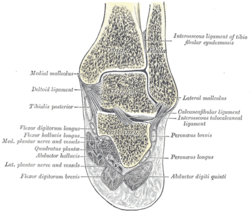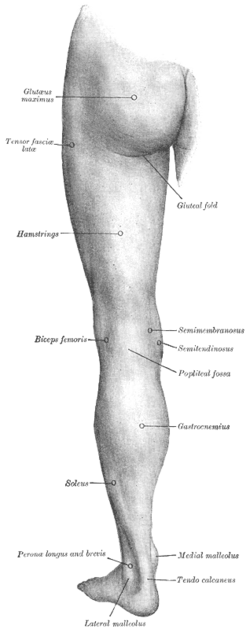Malleolus
This articleneeds additional citations forverification.(April 2012) |
| Malleolus | |
|---|---|
 Coronalcross-section through the right ankle showing thelateral malleolus(right) andmedial malleolus(left) | |
 The left leg, with themedial malleoluslabeled at bottom right. | |
| Details | |
| Identifiers | |
| Latin | malleolus |
| TA98 | A02.5.07.014 |
| TA2 | 1442 |
| FMA | 35502 |
| Anatomical terms of bone | |
Amalleolusis the bony prominence on each side of the humanankle.
Each leg is supported by two bones, thetibiaon the inner side (medial) of the leg and thefibulaon the outer side (lateral) of the leg. Themedial malleolusis the prominence on the inner side of the ankle, formed by the lower end of the tibia. Thelateral malleolusis the prominence on the outer side of the ankle, formed by the lower end of the fibula.
The wordmalleolus(/məˈliːələs,mæ-/[1][2]), pluralmalleoli(/məˈliːəˌlaɪ,mæ-/), comes from Latin and means "smallhammer".(It iscognatewithmallet.)
Medial malleolus
[edit]The medial malleolus is found at the foot end of thetibia.The medial surface of thelower extremity of tibiais prolonged downward to form a strong pyramidalprocess,flattened from without inward - the medial malleolus.
- Themedial surfaceof this process is convex and subcutaneous.
- Thelateralorarticular surfaceis smooth and slightlyconcave,and articulates with thetalus.
- Theanterior borderis rough, for the attachment of the anterior fibers of the deltoid ligament of theankle-joint.
- Theposterior borderpresents a broad groove, themalleolar sulcus,directed obliquely downward and medially, and occasionally double; this sulcus lodges the tendons of thetibialis posteriorandflexor digitorum longus.
- Thesummitof the medial malleolus is marked by a rough depression behind, for the attachment of thedeltoid ligament.
The major structure that passes anterior to the medial malleolus is the saphenous vein.
Structures that pass behind medial malleolus deep to theflexor retinaculum:
- Tibialis posterior tendon
- Flexor digitorum longus
- Posterior tibial artery
- Posterior tibial vein
- Tibial nerve
- Flexor hallucis longus
Lateral malleolus
[edit]The lateral malleolus is found at the foot end of thefibula,of a pyramidal form, and somewhat flattened from side to side; it descends to a lower level than the medial malleolus.
- Themedial surfacepresents in front a smooth triangular surface, convex from above downward, which articulates with a corresponding surface on the lateral side of the talus. Behind and beneath the articular surface is a rough depression, which gives attachment to theposterior talofibular ligament.
- Thelateral surfaceis convex, subcutaneous, and continuous with the triangular, subcutaneous surface on the lateral side of the body.
- Theanterior borderis thick and rough and marked below by a depression for the attachment of theanterior talofibular ligament.
- Theposterior borderis broad and presents the shallowmalleolar sulcus,for the passage of the tendons of theperonæi longusandbrevis.
- Thesummitis rounded and gives attachment to thecalcaneofibular ligament.
A major structure that is located between the lateral malleolus and the Achilles tendon is the sural nerve.
Clinical significance
[edit]Fracture
[edit]Abimalleolar fractureis afractureof theanklethat involves thelateral malleolusand themedial malleolus.Studies have shown[3]that bimalleolar fractures are more common in women, people over 60 years of age, and patients with existing comorbidities.[3]
Atrimalleolar fractureis afractureof theanklethat involves thelateral malleolus,themedial malleolus,and the distal posterior aspect of thetibia,which can be termed theposterior malleolus.The trauma is sometimes accompanied byligament damageand dislocation.[4]
Additional images
[edit]-
Ankle joint. Deep dissection. Lateral view.
-
Ankle joint. Deep dissection.
-
Ankle joint. Deep dissection.
-
Image showing the lateral malleolus as part of the fibula.
-
X-ray avulsion fracture of the summit of the left lateral malleolus.
References
[edit]![]() This article incorporates text in thepublic domainfrompage 5of the 20th edition ofGray's Anatomy(1918)
This article incorporates text in thepublic domainfrompage 5of the 20th edition ofGray's Anatomy(1918)
- ^"Malleolus".Merriam-Webster.com Dictionary.Merriam-Webster.Retrieved2016-01-22.
- ^"Malleolus".LexicoUK English Dictionary.Oxford University Press.Archived fromthe originalon 2020-03-22.
- ^abTejwani, Nirmal; et al. (2007)."Are Outcomes of Bimalleolar Fractures Poorer Than Those of Lateral Malleolar Fractures with Medial Ligamentous Injury?".Journal of Bone and Joint Surgery.89(7): 1438–1441.doi:10.2106/JBJS.F.01006.PMID17606780.Archived fromthe originalon 15 February 2010.Retrieved26 November2010.
- ^Orthopaedic Trauma Association (September 2007)."Ankle Fractures".AAOS.





